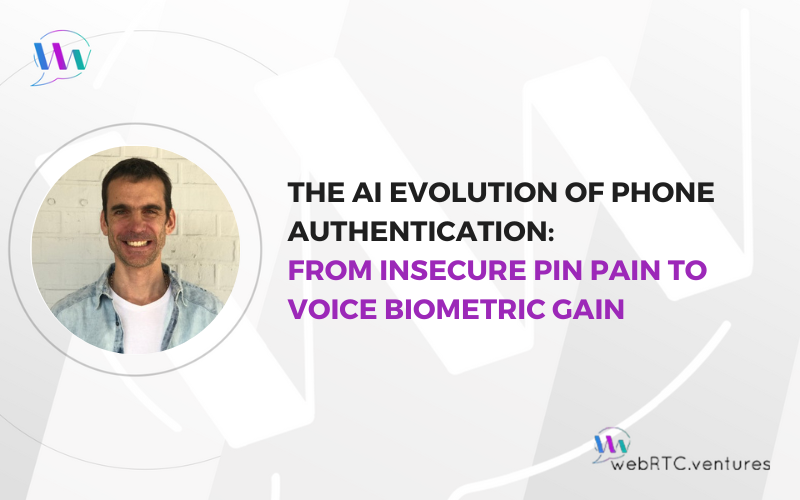In an era where artificial intelligence is transforming every aspect of customer service, Interactive Voice Response (IVR) systems remain a critical touchpoint for millions of daily interactions across call centers and customer service departments. As explored in my previous article on “Building a Smart IVR Agent System with LiveKit Voice AI”, conversational AI has revolutionized the IVR space. Yet, traditional phone authentication systems have proven insecure and create friction that drives customers away, adding a need for improved conversational IVR security.
With 61% of consumers reporting poor experiences with IVR systems and 51% abandoning calls entirely due to authentication frustrations, it’s time to reimagine IVR identity verification through modern voice authentication for IVR systems. The convergence of voice biometric authentication, smart IVR authentication, and Voice AI security offers a path forward where real-time voice verification not only strengthens IVR fraud prevention, but also enhances the customer experience.
The Authentication Crisis in Traditional IVR Systems
The telecommunications industry faces a critical authentication challenge. With account takeover fraud increasing 330% in the past two years and costing $6.24 billion globally, traditional PIN-based IVR authentication is fundamentally broken. Meanwhile, the voice biometrics market is projected to reach $10.9 billion by 2032, signaling a massive shift in how we approach phone-based identity verification.
For decades, IVR systems have relied on a familiar but frustrating dance: “Please enter your 16-digit account number… Now your date of birth… Now your mother’s maiden name…” This antiquated approach had become dangerously obsolete. According to Pindrop’s 2024 Voice Intelligence & Security Report, fraudsters successfully pass knowledge-based authentication (KBA) questions 92% of the time, which actually outperforms legitimate customers. This shocking statistic reveals that personal information like Social Security numbers, addresses, and security question answers are readily available on the dark web, often packaged and sold as complete identity profiles.
The National Institute of Standards and Technology (NIST) now explicitly advises against using personal questions as the sole form of authentication, recognizing that this approach provides minimal actual security while maximizing user frustration.
Add The IVR User Experience Crisis
Traditional IVR authentication creates a perfect storm of user frustration:
- 63% of callers are forced to listen to irrelevant options
- 54% complain the system prevents them from reaching a live person
- 46% say menus are too long
- 45% must repeat themselves multiple times
These pain points translate directly to business impact, with companies losing customers every year due to IVR-related abandonment. For healthcare providers, financial institutions, and other organizations handling sensitive data, the reputational damage from poor authentication experiences can be even more devastating.
Voice Biometrics and Layered Security Approach to Phone Authentication
Modern authentication workflows are revolutionizing the phone channel by combining multiple technologies including a new standard called voice biometrics to create a layered security approach that not only increases security exponentially, but it also completely improves user experience. This layered approach consists of using different authentication layer requirements depending on the risk of the operation.
Automatic Number Identification (ANI) + Voice Biometrics
The foundation of modern phone authentication begins the moment a call connects. Automatic Number Identification (ANI) provides immediate context about the caller, while voice biometric technology creates a very low friction and high security authentication baseline. Voice Biometric generates a unique “voiceprint” from the caller’s natural speech patterns to validate if the user is the owner of the phone line. Unlike passwords or PINs, voice biometrics analyzes over 100 unique characteristics including:
- Pitch and tone variations
- Speaking rhythm and cadence
- Vocal tract shape
- Pronunciation patterns
This passive authentication happens seamlessly in the background during natural conversation, eliminating the need for customers to remember or recite anything. Major implementations have shown remarkable results:
- HSBC reported a 50% reduction in fraud since implementing voice biometrics
- Barclays reduced authentication time from 90 seconds to 15 seconds
- 85% of financial institutions now consider voice biometrics critical to their security strategy
It’s worth mentioning that this technology is not perfect and comes with some flaws like not being able to authenticate the user when having heavy background noise or when the customer has a cold and his voice is not recognizable.
Also, VB techniques have some security challenges. With the fast development of AI, it’s becoming possible to use deepfake techniques to synthesize a voice and use it for what is known as synthetized voice fraud. However this kind of fraud is mostly detected by advanced voice recognition systems and is currently not a major threat. Voice biometrics is still considered one of the most secured authentication methods as of today.
To summarize, ANI can add direct routing and context by identifying the user right away while Voice Biometrics adds an authentication layer with very low friction for users. Together they provide a solid solution that can resist the most common theft techniques like spoofing and SIM swapping fraud.
To add security for higher-risk operations like bank transactions, etc. the layered approach can add other factors of authentication (2FA) such as One-Time Passwords with authenticator apps (TOTP) or a less secure but more convenient SMS OTP and Automated Phone Callbacks.
TOPT, SMS OTP & Automated Phone Callbacks
The way SMS and Authenticator App OTPs work is by having the system send an OTP and tell the user: “We have just sent a 6-digit code to your phone (or to your authenticator app in case of TOPT). Please enter the code now.” The user then enters the 6 digit code on the keypad and the system registers the DTMF input to validate it. Since the code is unique to the session and time-sensitive it proves possession of the registered device, eliminating spoofing. In the case of the authenticator app, it also eliminates SIM swapping fraud.
For scenarios where SMS OTP delivery fails or users have accessibility needs, automated phone callback technique provides a beautiful alternative. Instead of leaving customers stranded, the system can tell the user that it will call her back immediately, hang up the call and initiate an outbound call to the registered number. This approach has the same effect as the SMS OTP mechanism, eliminating spoofing. It is particularly valuable for visually impaired and elderly users who may struggle with reading SMS codes while in a phone call, ensuring inclusive access to services. It’s still considered less secure than Authentication App OTP, which also eliminates the risk of SMS swapping.
Implementation Challenges and Solutions for Voice Authentication
Implementing advanced authentication requires addressing several technical hurdles.
Integration with Legacy Systems
Challenge: Many organizations operate decades-old IVR infrastructure that wasn’t designed for modern authentication.
Solution: API-first authentication platforms enable:
- Gradual migration without system replacement
- Cloud-based processing that doesn’t require on-premise hardware
- Vendor-agnostic integration through standardized protocols
Regulatory Compliance
Challenge: Healthcare (HIPAA), financial services (PCI-DSS), and government agencies face strict compliance requirements.
Solution: Modern authentication platforms provide:
- End-to-end encryption for voice data
- Automated audit trails for all authentication attempts
- Configurable retention policies to meet regulatory requirements
- Real-time fraud detection with documented decision logic
Scalability and Performance
Challenge: High-volume contact centers need authentication that doesn’t create bottlenecks.
Solution: Cloud-native architectures deliver:
- Sub-second authentication decisions
- Automatic scaling during peak periods
- 99.99% uptime through redundant infrastructure
- Global presence for low-latency verification
Ready to Modernize Phone Authentication?
The transformation of phone authentication from painful PINs to intelligent voice biometrics represents more than a technology upgrade. It requires a fundamental reimagining of how we balance security and user experience. As AI continues to evolve both attack and defense capabilities, organizations that embrace modern authentication will build stronger customer relationships while protecting against increasingly sophisticated threats.
The question isn’t whether to modernize phone authentication, but how quickly you can implement these technologies before traditional methods drive your customers to competitors who have already made the leap. In an age where every interaction matters, can you afford to let authentication be the reason customers abandon your call?
Whether you’re building a new smart IVR system from scratch or securing an existing conversational AI implementation, we have the expertise to ensure your customers enjoy frictionless experiences backed by enterprise-grade security. Contact the WebRTC.ventures team today to discuss how we can secure, or build, your conversational IVR system with advanced voice authentication technology.
Further Reading:
- Building a Smart IVR Agent System with LiveKit Voice AI: Say Goodbye to “Press 1 for Sales”
- How to Build Voice AI Applications: A Complete Developer Guide
- How to Build a Serverless Voice AI Assistant for Telephony in AWS using Twilio ConversationRelay
- How to Automate Voice AI Agent Testing & Evaluation with Coval
- Optimizing Prompts for Real-Time Voice AI
- On-Premise Voice AI: Creating Local Agents with Llama, Ollama, and Pipecat
Sources:
- https://www.globenewswire.com/news-release/2024/07/03/2908287/0/en/Global-Voice-Biometr[…]d-to-Reach-USD-11-14-Billion-By-2032-Astute-Analytica.html
- https://www.pindrop.com/article/ivr-iva-authentication-methods/
- https://cyara.com/solutions/voice-biometrics-testing/
- https://www.globenewswire.com/news-release/2024/12/23/3001382/28124/en/10-Billion-Voice[…]ion-End-User-Countries-and-Company-Analysis-2025-2033.html
- https://www.pindrop.com/research/report/voice-intelligence-security-report/
- https://www.speechtechmag.com/Articles/Editorial/Features/2024-State-of-AI-in-the-Speec[…]metrics-Both-Profits-From-and-Is-Plagued-by-AI-162532.aspx
- https://go.pindrop.com/resources/report/solving-the-authentication-puzzle-ccma/
- https://go.pindrop.com/resources/report/2022-voice-intelligence-and-security-report/
- https://www.pindrop.com/article/customer-authentication-guide/
- https://smallbiztrends.com/ivr-statistics/
- https://www.efani.com/blog/sim-swapping-statistics
- https://www.itv.com/news/2025-05-12/sim-swap-fraud-rises-by-1000-as-criminals-exploit-two-factor-authentication
- https://sekura.id/sim-swap-fraud-in-south-africa-2024/
- https://telehealth.org/blog/sim-swapping-smartphone/
- https://market.us/report/voice-biometric-solutions-market/
- https://www.kbvresearch.com/voice-biometrics-market/
- https://www.fortunebusinessinsights.com/industry-reports/voice-biometric-solutions-market-100509
- https://www.globenewswire.com/news-release/2024/08/06/2924715/0/en/Global-Biometric-Tec[…]ize-To-Worth-USD-171-98-Billion-by-2033-CAGR-of-13-97.html











